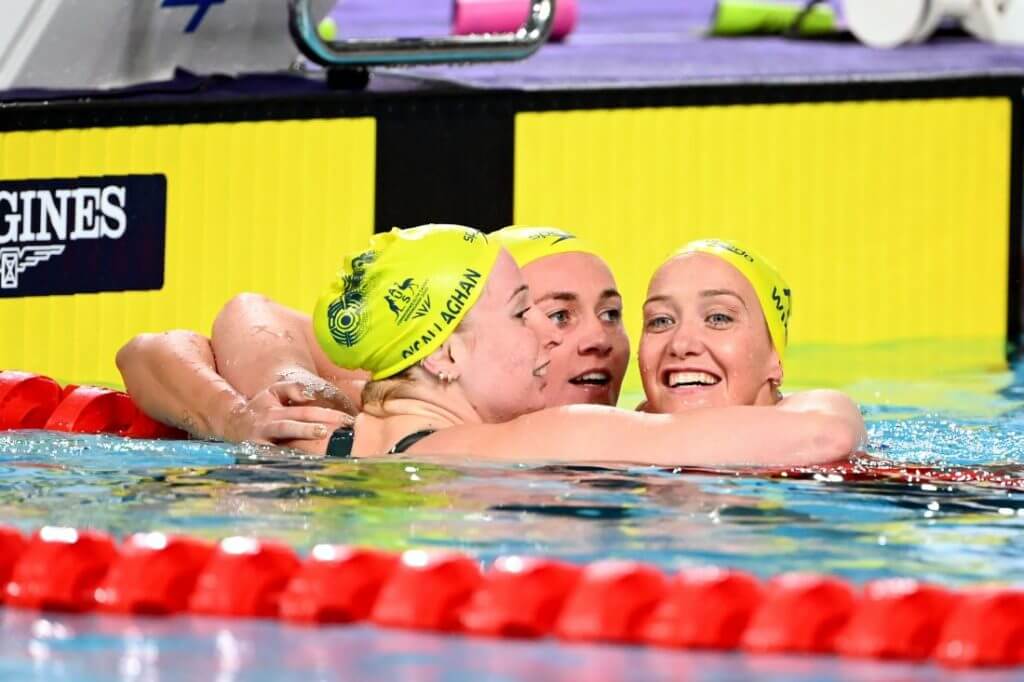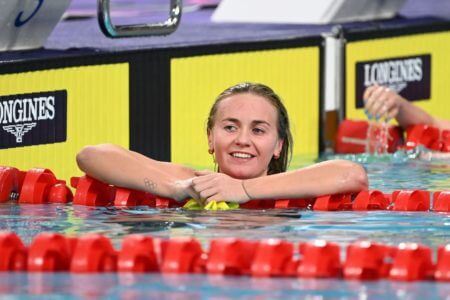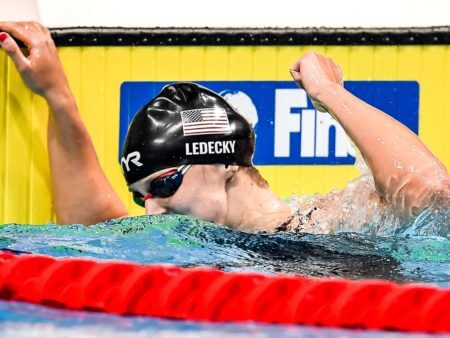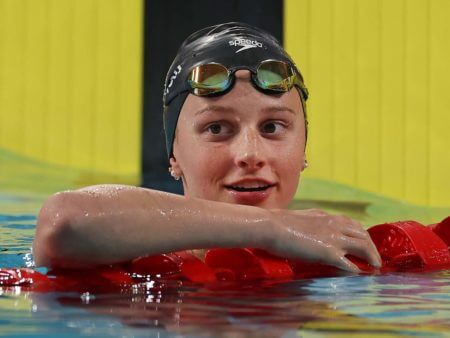Status Check: Golden Australians, Well-Rounded Americans Still Command Global Women’s Swimming

Status Check: Golden Australians, Well-Rounded Americans Still Command Global Women’s Swimming
An extremely busy summer of international racing has finally concluded after a two-month stretch that began with an “extraordinary” World Championships in Budapest and then included the Commonwealth Games and European Championships. There was a dominant nation at each of those competitions, with the United States securing a record-total of 45 medals at Worlds (although with several top names missing), Australia doubling any other country at the Commonwealth Games and Italy leading the way at a home European meet.
The results and medals of course have their own inherent value, but in an Olympics-focused sport such as swimming, it makes sense to assess performances with an eye toward what’s next. When all the results are taken together, who is in good shape with less than two years to go until the 2024 Paris Games, and who has a lot of work left to do?
Here, we will talk women’s swimming, where Australia and the United States remain the top nations and a teenager that secured individual world titles prior to her 16th birthday has joined the ranks of the very best. Plenty about this landscape can and will change over the next two years, but this is how everything sets up as of today.
Australia Still Nation to Beat
Last year, Australia officially rebounded from two very disappointing Olympics in a row by winning 21 medals in swimming and nine gold, including six individual women’s events and two relays. This year, it’s more of the same when you combine the results from this summer’s major meets.

Ariarne Titmus at this year’s Commonwealth Games — Photo Courtesy: Delly Carr
Ariarne Titmus did not compete at the World Championships, but she was brilliant once again in 2022. She had the year’s top times by far in the 200 and 400 freestyle, and in May, she broke Katie Ledecky’s world record in the 400 free. She won three individual golds at Commonwealth Games, including an 800 free performance when she reasserted her status as history’s No. 2 performer behind Ledecky.
Also missing from Worlds was Emma McKeon, who became the first woman ever to win seven medals in one Olympics last year. But when she did compete just over a month later at the Commonwealth Games? Still one of the world’s best in sprint freestyle and butterfly. And Australia’s third individual Olympic champion from last year, Kaylee McKeown, was not at her best this year, but she still was the world’s best 200 backstroker this summer and an elite force in the 100 back while posting the second-best time of all the competitions in the 200 IM.
Oh, and there’s a new addition to the Aussie golden girl club as 18-year-old Mollie O’Callaghan was the world champion and No. 1 swimmer in the world this year in the 100 free and No. 2 overall behind Titmus in the 200 free. O’Callaghan was a prelims relay swimmer at the Olympics last year, but this year was her first chance as a featured performer for Australia, and she was brilliant in that role.
Finally, Australia has such an embarrassment of riches in the sprint freestyles that the Worlds final in the 400 free relay was no contest for Aussie gold even with McKeon and veterans Cate Campbell and Bronte Campbell absent. Commonwealth Games brought a world record in the 800 free relay from a Titmus-and-O’Callaghan-led squad, and while the Americans did finish with the world title and world’s fastest time in the 400 medley relay, Australia is looming with breaststrokers Chelsea Hodges and Jenna Strauch both posting solid splits in support of standout legs from McKeown, McKeon and O’Callaghan.
Basically, Australia’s women have it all, individual superstars providing gold-medal opportunities across the board and depth required for relay powerhouse status. On the women’s side, this is the team to beat in all respects.
American Opportunities Galore
As for the other traditional force in women’s swimming, the United States certainly has some room to make up on Australia in the relay events, but otherwise, the Americans are in an enviable spot two years out from the next Olympics, with almost no glaring holes to speak of throughout the event lineup.
Yes, seriously. Not counting 50-meter stroke events (not contested in the Olympics), the U.S. won a medal in 12 out of 14 individual events at Worlds, and the only exceptions were the 200 free, which Ledecky skipped, and 100 breast, where Lilly King finished a close fourth despite dealing with health issues.

Katie Ledecky at this year’s World Championships — Photo Courtesy: Andrea Staccioli / Deepbluemedia / Insidefoto
Consider the makeup of this American team. There is Ledecky, still dominating the 800 and 1500 free globally after almost a decade in the position, and she won the fourth world title of her career this year with Titmus absent. King, Hali Flickinger and even Regan Smith are all veterans with large international résumés.
Perhaps most significantly, young swimmers who were rookies in Tokyo took large steps forward this year. Alex Walsh went from Olympic silver medalist to clearly the world’s best in the 200 IM. Torri Huske narrowly missed an individual Olympic medal last year, but this year, she easily won the 100 butterfly world title while also becoming the top U.S. performer in the 100 free and managing a difficult schedule at the World Championships with seeming ease and emerging with six medals.
Claire Curzan, Phoebe Bacon and 16-year-old Katie Grimes all won their first individual medals at a major meet this year, and another 16-year-old, Leah Hayes, made the most of her international debut by winning Worlds bronze in the 200 IM. Bella Sims, 17, was a World Championships hero by anchoring the 800 free relay to gold in a mark more than two seconds clear of her individual best, and fellow teen Erin Gemmell also split under 1:55 this year as she propelled the U.S. to gold at the Junior Pan Pacific Championships. Additionally, 16-year-old Claire Weinstein went 1:56 this year from a flat start.
Sure, sprint freestyle remains a relatively weak spot, and U.S. fans will hope for bounce-back performances from King and 100 breast Olympic champion Lydia Jacoby in 2023, but all in all, the American women have plenty to build on.
Arrow Pointing Up: Summer McIntosh Carrying Canadian Torch

Summer McIntosh at this year’s Commonwealth Games — Photo Courtesy: Swimming Canada/Ian MacNicol
One year ago — heck, even three months ago — Summer McIntosh was a talented teenage swimmer with gobs of potential. Now, if not for the usual brilliance from Titmus and Ledecky this year, McIntosh might be the favorite for Female World Swimmer of the Year. That’s because the 17-year-old from Toronto was the best swimmer in the world by a significant margin in the 200 fly and 400 IM this year, and in the 400 free, she provided real challenges to both Ledecky (at Worlds) and Titmus (at Commonwealth Games).
McIntosh also posted a 200 free relay leadoff at Worlds that would have won gold in the individual event, and she won Commonwealth gold in the 200 IM, entering 2:08-territory in her fifth-best event. Even her 100 free is quick enough to make her a real contributor to Canada’s 400 free relay going forward. She stunned with a 53.33 split in her last race of the Commonwealth Games.
And last Thursday, McIntosh celebrated her 16th birthday. But already, McIntosh is fully ingratiated with a Canadian team that seems to improve its standing on the global stage each year. Kylie Masse remains one of the world’s most consistent backstrokers, and Penny Oleksiak helped Canada win medals in all three women’s relays at Worlds for the first time ever plus a silver in the mixed 400 free relay. Maggie Mac Neil did not swim individual events at Worlds, but her Commonwealth gold in the 100 fly was a good reminder of her remarkable abilities in that event.
To recap, that’s a rising-star-turned-world-beater, numerous individual medalists at global-level competitions and relays among the best in the world in each discipline. That combination makes Canada the clear choice as the No. 3 women’s swimming nation in the world.
Arrow Pointing Down: European Women Continue to Struggle
After years of Sarah Sjostrom and Katinka Hosszu dominating the sport, it was an odd sight to behold as Europe’s women won just four medals and zero golds at the Tokyo Olympics, with two of those medals (including the only silver medal) coming in the 50 freestyle on the final day. It did not help that a fractured elbow cost Sjostrom months of her Olympic preparation, but a single swimmer should not represent an entire continent.
The performances were better this year as European women captured 13 medals at the World Championships, with Sjostrom leading the way as the gold medalist in the 50 free and 50 fly. Sprint breaststroke became a huge strength for Europe as Italy’s Benedetta Pilato captured a surprise gold medal in the 100 breast ahead of Germany’s Anna Elendt and Lithuanian comeback swimmer Ruta Meilutyte, and Meilutyte and Pilato later went 1-2 in the 50 breast.
But compare that to the men’s side, where the three best swimmers in the world right now all hail from Europe: Hungary’s Kristof Milak, France’s Leon Marchand and Romania’s David Popovici. Italy’s men won 400 medley relay gold at Worlds led by individual world champions Thomas Ceccon and Nicolo Martinenghi.
At the recent European Championships, only five winning times in women’s events would have been quick enough to reach the medal podium at Worlds: the four 50-meter races and the 100 breast (Pilato). We’ll see if Europe’s women can produce enough improvement over the next two years to be serious competitors with the likes of Australia, the U.S., Canada and even China in Paris.



